
The medieval cuisine,
it is mostly stews that cook in the pot (meats on the spit are reserved for lords and roasters)
Stews, composed of beef, mutton or poultry, cook with seasonal vegetables, so to speak, a soup with pieces and to serve this, are slicers that are used, a slice of bread thick enough on which meat and vegetables are deposited.
For ...

The medieval cuisine,
it is mostly stews that cook in the pot (meats on the spit are reserved for lords and roasters)
Stews, composed of beef, mutton or poultry, cook with seasonal vegetables, so to speak, a soup with pieces and to serve this, are slicers that are used, a slice of bread thick enough on which meat and vegetables are deposited.
For the bourgeoisie, this cuisine accommodates spices brought back from the East, the end of the 15th century is a time when eating well is an integral part of life, celebration and the pleasure of living. The kitchen offers the most unexpected and elaborate mixtures of scents, colors and flavors.
"BNF Gallica (Source gallica.bnf.fr / City of Paris / Historical library) The trades and corporations of the city of Paris: 14th-18th centuries. General ordinances, food trades [...]
TITLE IX. ROTISSERIES.
By letters patent of Louis XII, dated March 1509, where they appear for the first time in a separate community, the roasters attribute to themselves, except for a few deletions relating to the cooking of butcher's meats, the articles presented to Etienne Boileau by the cooks. -oyers, under the title LXIX of the Book of Trades.
Circumstances easily explain this transformation. The profession of cooks was free, that is to say open to all, and without very special attribution since it was subsequently divided into several branches to disappear itself. The roasters, who formed a good part of it, set themselves apart and, in their private interest, inscribed at the top of the statutes from 1509 the reception and purchase of the trade, reserving the monopoly of troussing, adorning, roasting poultry and game with hair and feathers, lambs and kids. They have in reality only two texts of statutes, those of 1509, reproduced from the 12th century and those of 1744 i2). The simple confirmations which meet in the interval prove sufficiently that there was no statutes between these two dates and the letters of 1744 declare it in positive terms. The life of the community appears only in its lawsuits with the henhouses, regratters and other trades known as "people of mouth". The judgments always give them victory; no one apart from them could burn the poultry, but trials were always repeated on the same grounds. The letters of François Ier settle this dispute by confirming their statutes; the other stops all look the same ... "
"Recommendations on the use of salt" I said that any excess leads the right man to decease. Thus the too frequent use of salt harms the eyes of the face, and for eating too much salt, such Galand has long suffered. I say more than the seed, the salt takes away the abundance. Thus, Mes-Dames de Paris; Take care now, and each of you takes care, to take advantage of this word, To put too much salt in the pot "
Health: "archaeological excavations have uncovered St Mary's Sptital in London, a hospital opened in 1197. The excavations have uncovered surprising facts about the health of people at that time, in fact we see that most of the Archaeologists also discovered that the skeletons were of normal size, the findings covered that the diet at that time did not contain massive amounts of simple carbohydrates like we consume today. "
Subcategories
Medieval bread
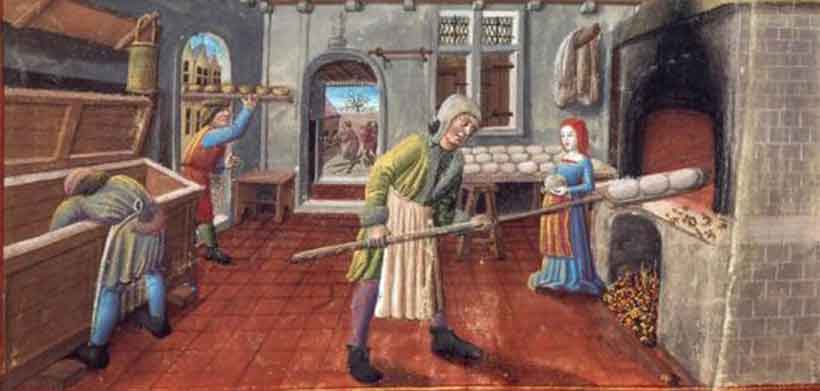
Medieval bread (a medieval recipe)
Bread represents the main part of the medieval diet. There is a culinary term for all dishes accompanied by bread from the 12th century, the companage (from the Latin cum, with and panis, bread).
Generally speaking, the well-to-do people of the towns and countryside love white bread, pure wheat, finely sifted. (which gives a very white crumb and leads to a loss of half).
The bread of peasants and more modest people is brown or wholemeal, as are the slices on which solid foods are placed during meals (slicers). These breads are of different quality and weight, but they are round and have little or no salt.
Depending on the region, the bread could include several cereals. Half of the cultivated fields were sown with wheat, the other half was divided between barley, oats, rye and millet. "Buckwheat, i.e. buckwheat, only appeared at the end of the Middle Ages and in the west of France,
Bread was kneaded at home by the women in the country and was baked in the collective oven, often the property of the lord. Breads weighing up to 7 kilos could be rare and spaced out (only one or two in some regions).
Around the 14th century, very precise rules were put in place by Charles V in 1366: the talmeliers could only make breads of the same weight, with a single flour, and at the same price. They will make two kinds of bread, one of such weight of 4 deniers, and the other of 2 deniers. In 1439, a fixed price for bread was adopted.
Cereals were also eaten in the form of porridges or cakes, mainly in Eastern Europe. In Northern Europe, from Great Britain to Poland, oatmeal porridges were consumed. The Welsh people eat a kind of oatmeal for soup with leeks, butter, milk and cheese cut into pieces. In Northern Italy, Sorghum Polenta is eaten. The Lombards eat panicum or millet with milk.Medieval pâtés

The pâtés were prepared with a crust by pastry cooks with different meats and flavoured with spices and herbs.For better conservation, we have meals in glass jars. These products will keep for 24 months at room temperature. (All recipes made without preservatives).
Medieval sauces
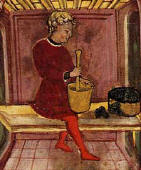
They give aroma to pâtés, dishes, roast meat, boiled meat, fish and are an incentive to the palate. They are coloured ( blue, green, yellow, white, pink ...) and often acid or bitter-sweet. They are most often thickened, fatless, with toast, ground in mortar, soaked in broth and sifted. Binding bread could be replaced by a link to the almond powder especially in the south of France. The thickening in almond powder may be the substituted to the thickening in brea, especially in south of France. The thickening, whether with bread or with almonds, develops a velvet under the tongue, and acidulous and perfumed flavours. Fruity and spicy, they also play a dietical part. These products will keep for 24 months at room temperature. (All recipes made using no artificial preservatives).Salted cakes
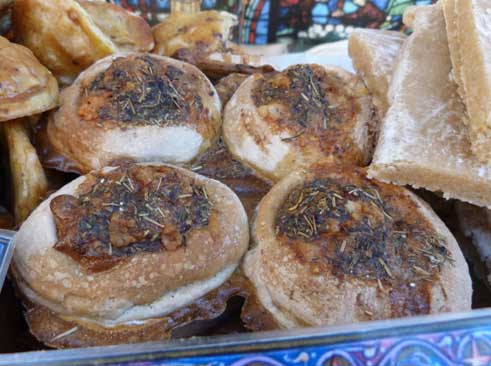
Salted cakes
Savoury cakes from the Middle Ages
The pastry cooks in the Middle Ages from the 13th to the 15th century, made oublies and savoury pâtés.
We can distinguish:
the oubloyers make the forget-me-nots, the hosts and singing bread (they are the oldest, statutes of 1240. Their apprenticeship lasts 5 years and the master's certificate costs 10 cents.
the pastry cooks make meat, cheese and fish pâtés (they appeared in 1440, their status specified the quality of the ingredients used. the apprenticeship lasts 3 years and the master's certificate costs 3 cents.
These two professions live in community.Cooked dishes
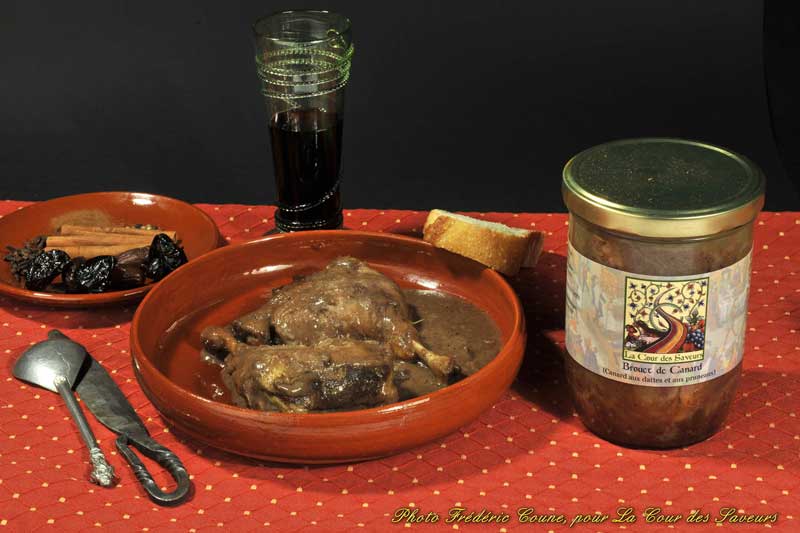
Cook caterers in towns are entitled to roast and cook meats and fowls, to make pork sausages flavoured with fennels and spices. Thus can they feed all those who have no kitchen at home. The basic equipment of the kitchen includes the caldron, pots and earth pans, the iron frying-pan corresponding to three types of cooking : boiling, braising and frying. Grils and grids appear only in urban places and castles. Advice is given to accompany the dishes with saffron rice, mashed field beans, lentils or turnips, served with red or white wine according to the dishes.Verjus
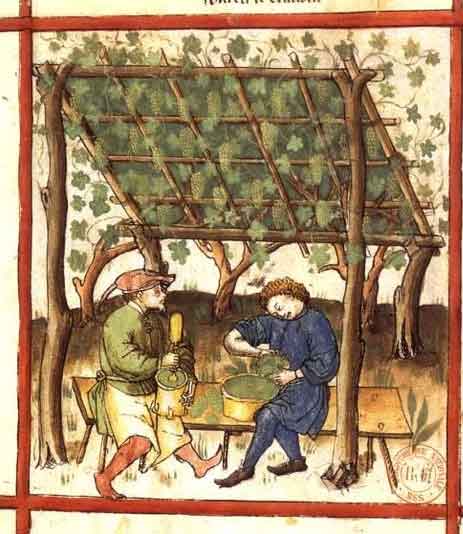
The verjuice
Verjuice is an acid green juice from green grapes mainly picked before harvest or green on the vine.
It can also be prepared with lemons, bitter oranges, parsley, sorrel, currants and other green fruit juices...
To preserve it, salt is added (as there is no pasteurization yet).
Verjuice, like vinegar, is reputed to be cold, it facilitates digestion and is therefore part of medieval dietetics. It is sometimes associated with spices, classified as hot.
Vinegar is used in winter with pork and beef.
and verjuice in the summer with poultry and pork.
The acidic taste has almost been lost today, it can be found in the cooked dish of pork with verjuice.
In town we buy it from sauce makers who also sell mustard.Herbs
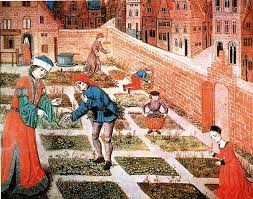
Herbs, vegetable or medicines are cultivated in medieval gardens, occasionally called "orchards", usually in divides into several gardens. The Orchard, a really pleasant garden in the Middle Ages in which various trees are planted, fruit trees, shrubs, groves and rose-trees. - The herb bed, planted with tinctorial, condimental and medical herbs. - The kitchen garden whose borders are encompassed with bricks, tiles or willow stems is grown with "pot herbs" leguminous plants or roots. The "Préau" can have different meanings according to the author (arbour) In general it is a small garden closed on three sides by lattice up which roes-trees climb. People could sit there on green benches among daisies, strawberries and aquilegia. The flowered meadow is an area sown with wild flowers that will be an inspiration for the millefleurs tapestries, late XVIth century. Among these flowers : the violet, the periwinkle, the primrose, the kitchen garden, a preserved area for the family mother. In a way, they express a hidden part of medieval civilization, a part as discreet as the perfume of calamint, fascinating enough for us to make a pausevegetable pates
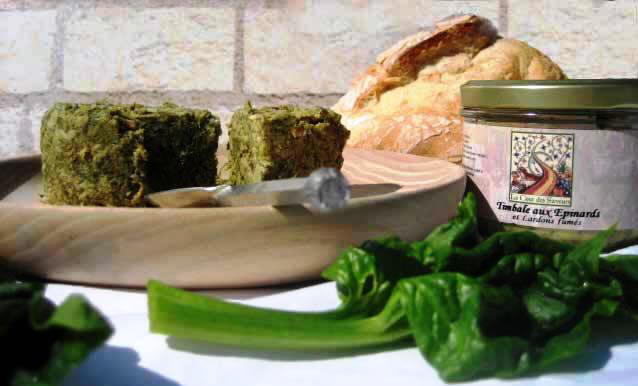
Vegetable flans were prepared in many monasteries and abbeys. Conseration at room temperature for 24 months. (All recipes made without preservatives)The Entremets

Between two services, the entremets was a disconnect between the roast and the service. The entremets are often set pieces: cook then presents a swan or peacock covered all his feathers as if vivant.It is also the time where we let jugglers, actors and ménestrels enter. There could be a fun and sweet dishes like fromentée, porridge optionally colored with saffron or savory offered to guests.Medieval dessert
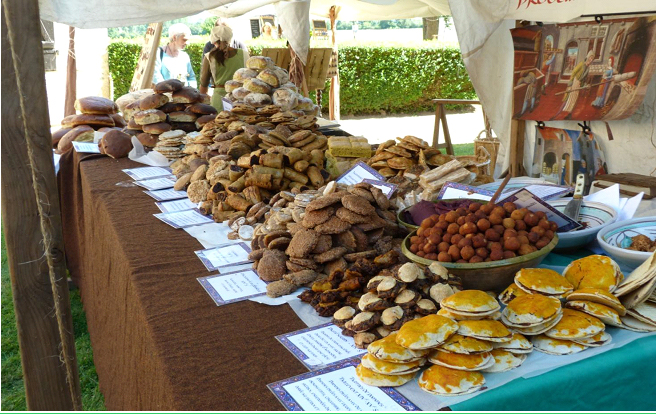
The dessert in the Middle Ages, it corresponds to the third or fourth course before leaving the table with:-sweet dishes : pudding, tarts, crustards, patties, wafers, doughnuts, pancakes, marzipan cakes (almond cakes), compotes, creams and fruit cooked in hyppocras.
-salt dishes custards, tarts, cheese pies (marzipan turnovers), doughnuts (ancestors to ravioli) wheat foods to go with the meats, venisons.
The dessert at less festive meals often was dry fruit and cheese (sweet and salt dishes at the end of the meal are separated into distinct courses later in the XVth and XVIth centuries, when sugar is imported in larger quantities.
Yssue of table
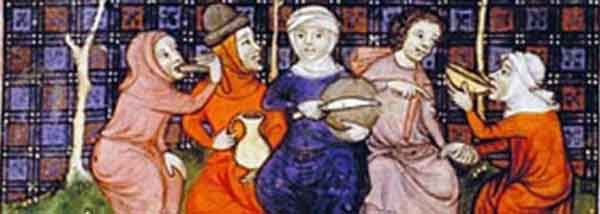
Leaving the table : the end of a banquet is generally associated with the "boute-hors" that designated crystallized fruit, crystallized spices, dragées, nougat eaten after the meal with hypocras or sweet wine to make the breath sweet and the digestion easier : music and dance can accompany it.Medieval drinks

Medieval drinks
What was drunk? Water first, called'' eve'' water in north of France,'' and'' aigue in south of France (poured with the beak if an ewer) and also various alcoholic beverages. In cities and in some places (Mont St Michel, for example) without any fountains, wine is drunk to avoid an intoxication with cloudy water stored in tanks.
Viticulture is growing considerably in the Middle Ages. Most peasants cultivate a few winstocks. light wines, especially white are preferred. Full-bodied red wines become fashionable in the XIVth century
The vines surronded the cities, including Paris, famous for its wines hills Conflans, Fontenay-sous-Bagneux (now Fontenay-aux-Roses), Montreuil, Issy, Vanves, Clamart, Noisy le Grand, Meudon, Suresnes, Nogent, Montmartre - which remains a'' last'' square.
Among the famous vineyards Beaune, St. Pourçain, Muscadet, Arbois, Malvasia Orleans, La Rochelle, or Nerac Picque-Ardents. Besides Bordeaux and its wines clairets'''' which became clarets, went to full aisles to England and Flanders.
The wine was consumed daily in the larger part of France and in the west of the Mediterranean basin where the vine was cultivated. Further north it remained the privileged drink of the middle and higher classes ; the workers preferred beer, cider or a drink made from pears.
The hypocras wine flavored with spices, sugar or honey and moretum with blackberries and raspberries were very popular at the end of the banquet meal
Mead (hydromel) was mainly consumed for its medicinal qualities.Medieval flavors
Medieval flavors from Avicenna's Canon, there are 8 different flavors: sweet (represented by honey), fat (butter), bitter (nuts), acid or sour (vinegar), austere tightened (unripe citron - related species of lemon), bitter, and piquant (spices). Other texts give: insipid (the white of egg )
This classification is not suited to the four elements (air, earth, fire and water), but there are conversion tables such as Bartholomy the Englishman (Book of properties of things, fifteenth century) :
Piquant XXX XXX bitter warm XXX XXX salt XXX XXX
fat XXX XXX soft temperate XXX XXX
insipid XXX acid XXX austere cold XXX sour XXXIn The thirteenth century, Aldebrandin de Sienne, living in Champagne, wrote in French the "Plan body" diet book for a fairly large public. Here may be seen the advent of dietetics for the whole population.
The Tacuinum Sanitatis is a translation of a book written in Baghdad by Ibn Butlab in the Xth century. It contains tables presenting the qualities of foodstuffs. In 1260, the Latin version is written in 1260, probably for the account of the count of Manfred of Sicily. The second is published in Italy in the XVth century. Two texts are published : the first one, quite complete, is a good adaptation of the original. The second is published in Italy in the XVth century, finely decorated, each page contains an illustration with little text. Cream cheese is described as cold and wet. It is better if it comes from the tempered milk from healthy animals. On the positive side, it softens and fattens the body, but it causes constipation; this unfortunate event may be avoided by almonds and nuts (warm and dry nature).A Greek legend will have it that medecine was invented as a consequence to an alimentary problem. It is believed in the Middle Ages there was a correspondence between the human body on which four moods operate (blood, phlegm, yellow bile and black bile), in conjunction with the 4 elements. Blood is warm and humid as air, and melancholy, cold and dry, corresponds to phlegm or earth.It influences foodstuffs : fowls that live in the air are also warm and humid whereas roots, in contact with the earth, are cold and dry. To keep one's health, a man must consume food that allows him to keep a balance between his moods. His food will vary according to his temperament.
cider vinegar
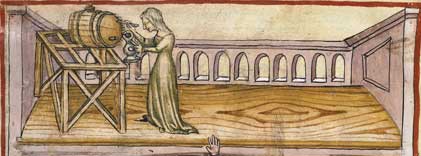
Vinegar is used in many French recipes from the Middle Ages.
" Ex Aldebrandin's recipe: fill a container halfway with good wine and do not cover. This way you will obtain a good vinegar. If you want to go faster: heat steel or stones, plunge them into wine without covering. Or put the container in the sun for two or three days with salt. Or fill a container with wine, cap it carefully and put it to boil in another container full of water. If you want to know whether vinegar is good or bad, here is a good procedure: sprinkle some on the ground or on a piece of iron. If the vinegar starts to boil, it is good. If it doesn't boil, it is bad.
-Use: As Rashmi Patni notes its transformation into an acidic element, the vinegar keeps some of the heat of the wine in it, so that one finds simultaneously in the vinegar opposite qualities hot and cold joined to the dryness. ». It is therefore a powerful remedy against obstructions; it counterbalances profitably the excess heat that can be found in certain meats and the excess moisture contained in fish. Its uses are varied. It is used to wash certain foods, such as snails, which must be rinsed in water until they no longer produce slime; then once in salt and vinegar and then put them to cook in water.
-Vinegar can give a sweet and sour taste to a preparation, the use of vinegar is used to embellish meat, venison of deer and wild boar, offal.
It is used to make "hot" sauces that accompany the "coldest" meats, it also season fatty fish and oysters. To attenuate the strength of the vinegar we add wine or beef broth.
Vinegar is also used to season salads. Described in feasts as early as the 15th century. The Tacuinum sanitatis advises to use vinegar to improve parsley, arugula, watercress or escarole and specifies that the consumption of olive oil must be balanced by vinegar.
Vinegar is used to preserve food, as shown by Master Martino in the middle of the 15th century, who advises, to keep fish, wine or vinegar healthy, the latter giving it a "better taste than simple salt water". The Tuscan cookbook by the poet Giosuè Carducci recommends that to preserve partridges or chickens, they should be boiled and then left for three days in vinegar before being placed in a container filled with wine and carefully sealed.Medieval gift
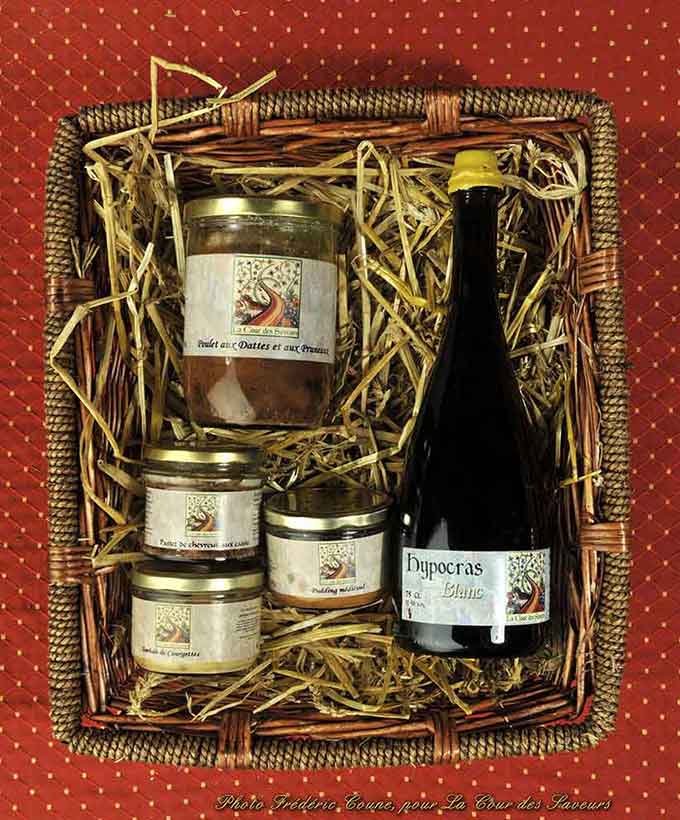
Specify the products that you choose during the final recording of your order in the "comments".
You can also add a note that we will follow.
For Mother's Day, Father's Day, Christmas, friends, Valentine's Day, surprise, birthday, thank you ...
At your request, we can write a greeting card (text us also specify in the "Comments".















